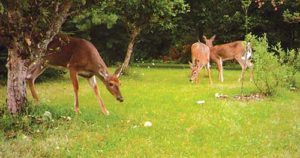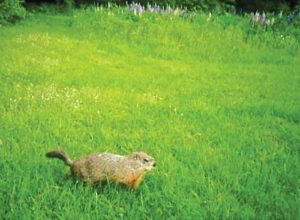 |
| Without a contiguous perimeter of metal deer fencing that is at least 8 feet tall, these animals are likely to enjoy your crops. |
 |
| Anyone can set a live trap anytime and relocate woodchucks, raccoons or skunks. |
By Caleb Goossen, Ph.D.
The three most common mammal pests that gardeners ask me about are deer, woodchucks and small rodents. Woodchucks and small rodents seem to be able to find gardens anywhere, but gardening in town can mean freedom from browsing deer – although not always! In addition to the frustration of seeing your hard work disappear overnight, animal pests in the garden present a food safety concern: You don’t want unplanned manure showing up.
Although gardeners with more grace than I can find peace in an unwritten agreement to grow enough food to share with their uninvited animal visitors, my experience has led to frustration that animals do not seem to be aware of the agreement and do not stick to just their share of the harvest.
Repel, Exclude or Reduce
Upon seeing evidence of an animal interloper (ideally beforehand), management tends to fall into three categories: repellence, exclusion and population reduction. Of these, exclusion is often the most reliable when done thoroughly, but exclusion can be more difficult as the size of the animal decreases. Mice can squeeze through openings that are just larger than a quarter-inch. Fortunately, the impact that you can have on the overall pest population in your vicinity increases as the size of the animal decreases: Mice don’t have nearly the traveling range that deer have. Similarly, woodchucks usually show up in the fall as young adults leaving their parents’ territory, so keeping your resident population in check tends to free you of their presence until the following season when that year’s litter sets off from neighboring families (which produce only one litter per year). Small rodents, however, can have many litters per year and build their populations much faster. Luckily many other predatory animals help check their population.
To repel small rodents some people try planting a solid barrier of peppermint or using peppermint oil as an applied deterrent, but I can’t vouch for its efficacy – and peppermint can be hard to keep contained to where you planted it. While mice can cause havoc by getting into freshly planted seedlings, voles are often the rodents that cause the most damage in a garden or greenhouse. Gardeners typically have to trap and remove them from the area to deal with them. Voles love to run in “tunnels” through vegetation just above or slightly below the surface of the soil. All rodents like to travel along the length of something. Given those tendencies, keep paths and the garden perimeter trimmed low to discourage rodents by making them feel more exposed, and place vole traps perpendicular (for snap traps) or in line with (for tunnel-style live traps) greenhouse walls or any long contiguous surface in the garden so that the rodents encounter the traps while traveling a normal path. I prefer peanut butter as a bait for mice, but voles are vegetarian and are more responsive to a small apple slice. (I’ve even used a beet slice successfully.) If I’m not sure what type of rodent is causing damage, sometimes I’ll set a trap with a small apple slice with some peanut butter on it.
If you opt to reduce the resident population of woodchucks or deer, be sure to comply with state laws. You don’t need a license to shoot a woodchuck (or porcupine or red squirrel), and it’s open season for hunting them year round except on Sundays. Anyone can set a live trap anytime and relocate woodchucks, raccoons or skunks, but lethal trapping must abide by Maine trapping laws, which boil down to having a trapping license and trapping only in the appropriate season. A local wildlife game warden can link homeowners with a state-licensed animal damage control professional who will trap nuisance critters for a small fee. According to Maine Statute (https://legislature.maine.gov/statutes/12/title12ch921.pdf), “the cultivator, owner, mortgagee or keeper of any orchard or growing crop, except all types of grasses, clover and grain fields, may take or kill wild animals or wild turkeys night or day when the wild animals or wild turkeys are located within the orchard or crop where substantial damage caused by the wild animal or wild turkey to the orchard or crop is occurring. For purposes of this section, corn is not considered grain.” Keel Kemper, regional biologist with the Maine Department of Inland Fisheries & Wildlife, told The MOF&G that this is technically correct but is not ideal. There are better ways to solve deer problems in crops, he says, suggesting that farmers and gardeners go toward fencing options. The department describes several methods to prevent conflicts at https://www.maine.gov/ifw/fish-wildlife/wildlife/living-with-wildlife/avoid-resolve-conflict/deer.html, which also says, “If deer damage is occurring on commercial property, contact a MDIFW game warden or regional wildlife biologist, who can assist you in evaluating damage-control options.” Kemper also notes that anyone who shoots a deer in the garden must notify the Maine Warden Service of the shooting within 12 hours.
Deer are best dealt with preemptively rather than scrambling to react to feeding damage. Methods of repelling or excluding deer rapidly lose efficacy when deer realize just how tasty your garden “salad bar” is. Compound that with the rapid transition that deer can make in the autumn, from feeding on diminishing summertime wild browse species to enjoying your tender crops, and an ounce of prevention truly is worth a pound of cure. By “training” local deer to avoid your fields, you have a better chance of keeping them away from your crops before they can do any damage than if you try to keep them out after they have caused harm – and gotten a taste for the crop.
The gold standard for excluding deer is a contiguous perimeter of metal deer fencing that is at least 8 feet tall. Installing these fences can be expensive, particularly if you need many gates, but ongoing labor is much less than maintaining temporary electric fences – and you can use the fence as a trellis for deer-resistant plants. Many farmers say that the peace of mind alone from installing a permanent deer fence was worth more than anything.
Temporary electric fencing is probably the more common and second most effective approach for excluding deer, but the devil is in the details with electric fencing. Many people have preferred setups, swearing by added height, double-perimeter fences spaced far enough apart to make jumping over both difficult, or other complicated setups. In my experience a simple, single-perimeter, double course of polytape electric fence is usually enough – with a few important caveats. First and foremost is getting the fence up before local deer know there is something they want to eat within it. Second is training local deer to know that they don’t want to go anywhere near your electric fence. Do this by baiting the fence with creamy peanut butter, lightly smearing it on the top row of polytape fencing every 6 to 8 feet (with the power turned off during application). Imagining deer sniffing that peanut butter and getting a zap on the nose may seem a little cruel, but it can prevent the need for lethal controls. Reapply the peanut butter every few weeks to reinforce the training of local deer, as they’ll keep testing. Lastly, perform regular electrical fence maintenance. That usually includes ensuring a high enough output of the fence charger, mowing and/or weed-whacking vegetation that can grow up to touch and partially ground the fence (lowering its “zap”), and if conditions have been dry long enough, you may need to dump buckets of water on the soil around the charger grounding rods to ensure good electrical conductivity to ground. Remember that none of the above will stop hungry deer in the fall, after their wild food sources have diminished, if they already know that tasty greens are inside the electric fence.
Regarding repelling and deterring deer, Andrew Smart, wildlife game warden for Unity, has seen success with a couple of tricks. First, simply attach a trash bag loosely to a fence post so that it can flap in the breeze. Smart says not to rely on such motion deterrents for more than a couple of weeks as deer soon get used to and ignore them. At the very least move them to a new location or take them inside for a while and bring them back out later. Second, Smart suggested putting a radio out to make noise in the field at night. That kept deer out of his strawberries for at least two months.
Smart and I have the same impression of odor-based repellents: They can be very effective if reapplied when needed (rain can wash them away), but regular applications of most commercial formulations can get too expensive for cost-effective control.
Caleb Goossen is MOFGA’s organic crop and conservation specialist. You can contact him at [email protected].
NOTE: A reader informed us that according to Maine Statute (https://legislature.maine.gov/statutes/12/title12ch921.pdf), “the cultivator, owner, mortgagee or keeper of any orchard or growing crop, except all types of grasses, clover and grain fields, may take or kill wild animals or wild turkeys night or day when the wild animals or wild turkeys are located within the orchard or crop where substantial damage caused by the wild animal or wild turkey to the orchard or crop is occurring. For purposes of this section, corn is not considered grain.” Keel Kemper, regional biologist with the Maine Department of Inland Fisheries & Wildlife, told The MOF&G that this is technically correct but is not ideal. There are better ways to solve deer problems in crops, he says, suggesting that farmers and gardeners go toward fencing options. The department describes several methods to prevent conflicts at https://www.maine.gov/ifw/fish-wildlife/wildlife/living-with-wildlife/avoid-resolve-conflict/deer.html, which also says, “If deer damage is occurring on commercial property, contact a MDIFW game wardens or regional wildlife biologist, who can assist you in evaluating damage-control options.” Kemper also notes that anyone who shoots a deer in the garden must notify the Maine Warden Service of the shooting within 12 hours.
